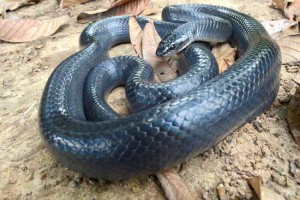Latest update November 26th, 2024 1:00 AM
Interesting Creatures…
Feb 01, 2015 Features / Columnists, Interesting Creatures in Guyana
The Mussurana
The mussurana or musurana (Portuguese muçurana) is a genus (Clelia) of colubrid snakes found in  Central America and South America, from Guatemala to Brazil. They specialize in ophiophagy, i.e., they attack and eat other snakes.
Central America and South America, from Guatemala to Brazil. They specialize in ophiophagy, i.e., they attack and eat other snakes.
Currently six species are recognized. These are: Clelia bicolor (Peracca, 1904); Clelia clelia (Daudin, 1803); Clelia equatoriana (Amaral, 1924); Clelia errabunda (Underwood, 1993); Clelia rustica (Cope, 1878) and Clelia scytalina (Cope, 1867).
They have other popular names in various countries, such as zopilota in Central America and cribo on some Caribbean islands (though they are not related to Drymarchon).
The mussurana has an average length of 1.5–1.6 metres (4.9–5.2 ft), but it can grow up to 2.4 metres (7.9 ft). When young, its dorsal colour is light pink, which becomes lead-blue when it is adult. The ventral colour is whitish yellow. It has 10 to 15 strong teeth at the back of the mouth (opisthoglyphous teeth) which it uses to grasp the head of the attacked snake and push it into its gullet. Then it coils its body around the victim, killing it by constriction (this is the reason this species is called a pseudoboa). Ingestion of the whole body follows. The long body of the ingested snake is compressed as a wave in order to fit into the mussurana’s gastrointestinal system. Mussaranas are oviparous.
Although mussuranas are rear-fanged and produce a mild venom, these snakes pose no danger to humans. Even when handled they usually do not bite. Very few envenomations have been reported and they were not fatal.
The mussurana is immune to the venom of the snakes it feeds upon, particularly the smaller Central and South American pit vipers of the genus Bothrops. It is not immune to the venom of the coral snake, though.
In the absence of other snakes, the mussurana can feed also on small mammals. It has been reported that at least some captive specimens will accept only live snakes as prey. Its preferred habitat is dense ground-level vegetation and its habit is diurnal.
In some regions, farmers keep mussuranas as pets in order to keep their living environment clear of pit vipers, which claim annually a large number of deaths of domestic animals, like cattle.
In the 1930s a Brazilian plan to breed and release large numbers of mussuranas for the control of pit vipers was tried but didn’t work. The Butantan Institute in São Paulo, which specializes in the production of antivenins, erected a statue of Clelia clelia as its symbol and a tribute to its usefulness in combating venomous snake bites. The mussurana’s immunity to bothropic venom was studied by the Brazilian scientist Vital Brazil in the 1920s.
Mussuranas are increasingly rare due to the disappearance of their prey and have disappeared in many habitats.
(Source: Wikipedia – The Free Online Encyclopedia)
Share this:
- Click to print (Opens in new window)
- Click to email a link to a friend (Opens in new window)
- Click to share on Facebook (Opens in new window)
- Click to share on WhatsApp (Opens in new window)
- Click to share on Twitter (Opens in new window)
- Click to share on Pinterest (Opens in new window)
- Click to share on Pocket (Opens in new window)
- Click to share on Tumblr (Opens in new window)
- Click to share on Reddit (Opens in new window)
- Click to share on LinkedIn (Opens in new window)
Related
Similar Articles

The Glenn Lall Show | November, 20th, 2024
Follow on Tik Tok @Glennlall
THE BLUNT OF THE DAY

Sports
Nov 26, 2024
SportsMax – Guyanese hard-hitting left hander Sherfane Rutherford will get the opportunity to shine on T20 franchise cricket’s biggest stage once again after being picked up by the...Features/Columnists
A call for more cultural centres
…Peeping Tom Kaieteur News- Burnham’s decision to divert the Indian Immigration Fund towards constructing the National... more
Rising Gun Crimes in the Caribbean: Urgent Action required by all
By Sir Ronald Sanders Kaieteur News – There is an alarming surge in gun-related violence, particularly among younger... more
Publisher’s Note
Freedom of speech is our core value at Kaieteur News. If the letter/e-mail you sent was not published, and you believe that its contents were not libellous, let us know, please contact us by phone or email.
Feel free to send us your comments and/or criticisms.
Contact: 624-6456; 225-8452; 225-8458; 225-8463; 225-8465; 225-8473 or 225-8491.
Or by Email: [email protected] / [email protected]
Weekend Cartoon














